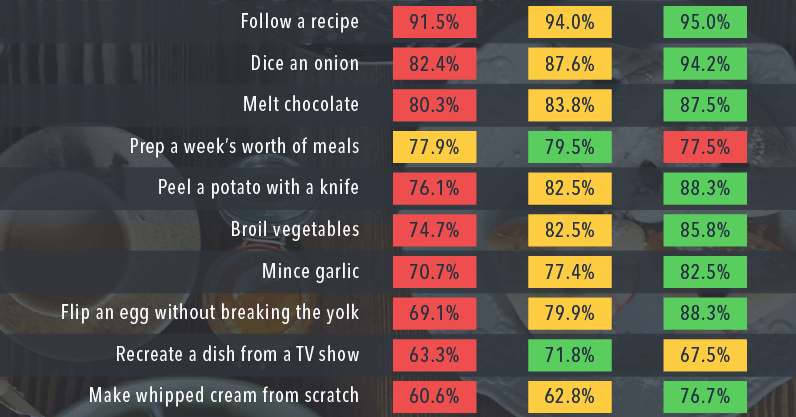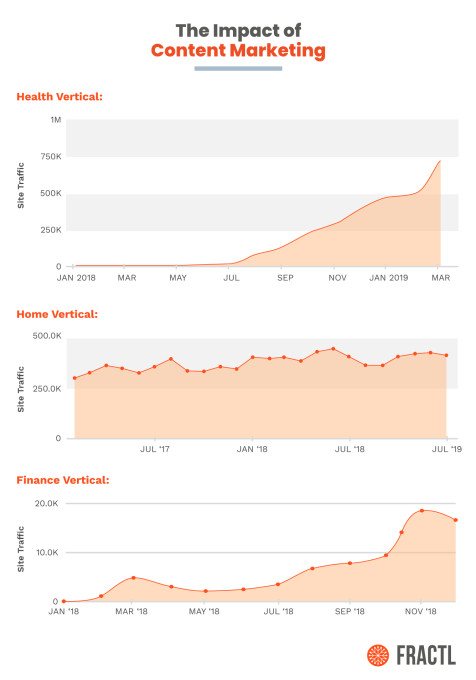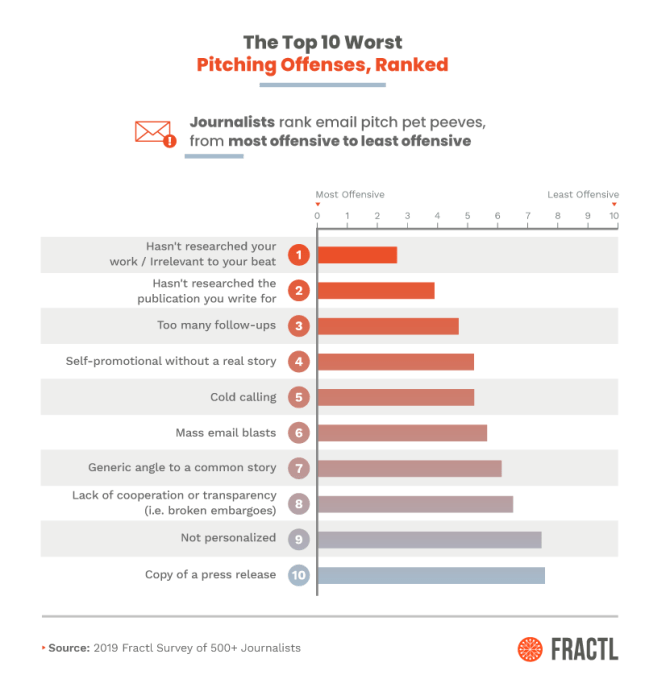Since our agency opened in 2012, we’ve learned a lot about how to build quality links through content marketing.
The industry has evolved for a variety of reasons, including Google’s algorithm updates and the state of digital media. We’ve had to change along with them.
Over the years, we’ve completely revamped the way we develop content ideas, report on results, identify pitch targets — everything except for our core belief: a combination of content marketing and digital PR is the best way to build top-tier links.
I want to share three of our biggest insights from our experiences adapting so you don’t have to start from scratch or wonder which of your processes needs an update.
Instead, you can get to building the best backlinks you can.
Building the best links requires original research
If you want major publications to link back to your site, you have to provide them with something that’s interesting, accurate, relevant to their audience — and new.
The concept of newsworthiness should be studied by every content marketer. Sometimes you’ll try to get press for something newsworthy related to your company, like a new product or acquisition. But you won’t always have new information; most of the time, it’ll be business as usual.
That’s where content marketing comes in. You create new studies, reports and surveys relevant to your industry that publishers want to talk about. This has been our strategy since the beginning, but as more people have started to pitch writers, the harder the work has become.
And that’s OK; it means only the best content is making it into these esteemed publications, which holds us to an appropriately high standard.
Here’s how we manage to meet that standard.
Selecting credible methodologies
First, consider if you have internal data that can be made public and would be of interest or value to your audience. Many brands overlook their own information when they’re sitting on fascinating data.
If you don’t have internal data you can leverage, consider the following methodologies:
- Public data sources: These are already public, so they’re not always “new,” but people aren’t typically rifling through boring PDFs and spreadsheets on their own. The key here is to see if anyone has analyzed and visualized this data in a meaningful, concise way for audiences. And there’s plenty of data to choose from; sometimes just simply searching for [your topic] + data in Google will reveal some great sources of information.
- Surveys: They’re certainly a popular way to come up with relatable, engaging content. We use SurveyMonkey to create our surveys and Amazon’s Mechanical Turk to collect respondents. Surveys are an awesome way of tapping into collective preferences and opinion, even for taboo topics (since they’ll remain anonymous). In pitching survey content, we’ve found publishers look for at least 1,000 respondents, so make sure you reach that number before promoting.
- Social data analysis: Millions of people share their thoughts and ideas on social media, so analyze that information to uncover interesting insights in your subject areas. You can start by trying social listening tools, or you can check out sites that have APIs, like Twitter. We’ve scraped social media as the basis for many of our content campaigns, so going beyond listening tools can certainly be worth it.
No matter what you select (or what other creative methodologies you come up with), make sure it’s very clear 1) in the project itself and 2) to any writers you reach out to how you collected and analyzed your data. We always include a methodology section at the end of our projects for reference; doing so helps communicate transparency and build trust with writers.
Think about which content you’ve read recently that had an impact on you. Maybe it was something related to the coronavirus that made you scared, or a video of a cat and dog snuggling that cheered you up.
Channeling emotion
It shouldn’t come as much of a surprise that when people have an emotional reaction to content, it resonates with them. Think about which content you’ve read recently that had an impact on you. Maybe it was something related to the coronavirus that made you scared, or a video of a cat and dog snuggling that cheered you up. (Fun fact: We’ve found that positive emotions are the most common emotions present in viral content.)
When brainstorming and executing content ideas, we’ve found that getting to the emotional core of the idea has helped us stay on course and deliver something people can really connect with.
Here are questions to ask yourself when you have a content idea:
- Is there a universal human experience at the center of this?
- If so, which feelings does the experience evoke?
- If not, who does the content impact, and how?
For example, for our client Nulab, we did a report called “America’s growing and shrinking businesses: Examining the life expectancy of businesses in the U.S.”
In it, we analyzed data from the U.S. Bureau of Labor Statistics’ Establishment Age and Survival report to examine “how long businesses typically operate, which industries close the fastest, and where businesses are expanding.”
But we didn’t quite pitch it that way. We pitched it with the emotional angle, and you can see the results in the media headlines. This is the exclusive coverage on Tech Republic:

Will your business survive? If that’s not emotional, I don’t know what is.
Tap into that when creating and pitching your content. Help writers see the emotionality. It’s what they want to write about.
Mastering the art of “tangential” content
The concept of “tangential” content is simple in theory, but it can be hard to identify ideas that fall into this category in practice.
Basically, content that’s too related to your brand might come across as salesy, or it might not be broad enough to appeal to a publisher’s audience. However, content that’s too unrelated to your brand will make your content look solely like a link play, raising eyebrows.
The sweet spot is “tangential” content, meaning it’s related enough to your core product/service offering.
To practice coming up with tangential content ideas, start by simply making a chart of your main topic areas and related subtopics.
Take, for example, this look at home repairs:

Using this line of thinking, we created a content project for Porch.com, a site that helps match visitors with home repair professionals.
Here’s a snippet of the project we created:


Do cooking habits by generation directly relate to home maintenance? No. Do they relate to home activities? Yes.
And there it is: The perfect middle ground. In this case, we pitched the content and secured coverage on The Washington Post, USA Today, Better Homes & Gardens, Bustle and other outlets.
Major results take at least six months to arrive
Many content marketers and link builders know this already. They understand that major, sustained shifts in organic traffic don’t happen overnight.
But it can be hard to tell stakeholders that they have to wait before their ROI can be proven.
What we’ve found is that skeptical people will want to see a few things:
Examples of result potential
If stakeholders wait, what can they expect on the other end? Getting a certain level of results is never a guarantee, of course, but it helps when people can visualize what there is to be gained from doing content marketing and link building work.
In my Pubcon Pro Las Vegas presentation, I showed examples of how we’ve built traffic for clients through content creation and digital PR. Note that on each of these graphs, it takes months before the major growth occurs:

Examples of competitors doing this work
Nothing is more persuasive than revealing that competitors are doing their own content work and reaping the benefits. It activates a sort of FOMO instinct in leadership while also illustrating that the work can get the results you’re talking about.
Note: As part of expectation setting, when you’re sharing this information, mention that there’s something to be said for deviating a bit from your competitors’ strategies. You want to do what’s best for your brand. You’re just trying to show how content marketing can help build links in general.
Here are some stats you can pull about competitors to use in your presentation for getting strategic buy-in:
- Keywords they’re ranking for that you’d like to rank for (try Ahrefs)
- Number of backlinks (and publishers that are linking to them)
- Social engagement they’re receiving on certain posts
A combination of tools like Ahrefs, SEMrush and BuzzSumo can get you this information.
Researching who you plan to pitch is half the job
Once you’ve created amazing content, the links don’t always roll in. Sometimes, if it really is awesome work and you have it well-optimized for search, the links can appear on their own, because people actively want to reference your work.
But the best links — those typically out-of-reach, super-authoritative links — come from top-tier publishers, and writers for those sites don’t usually have time to look at every company’s recent reports.
You’ll have to pitch it to them.
But writers get so many pitches, and there are a lot of ways you can alienate them with your email. A lot of people slack off at this stage, and it shows, leaving writers frustrated and unwilling to open as many cold emails.
If you’re nervous about this, it’s OK; you just have to put in the work up front. This is evidenced by our survey of 500+ publishers, who revealed their biggest pitching pet peeves:

The fact that so many people are pitching them content that’s completely unrelated to their beat is starting to really get on writers’ nerves. And with good reason! It shows that the person pitching doesn’t actually care about the writer’s audience.
You need to do you research and ensure you’re pitching the right person. Make sure to look into if the writer:
- Publishes on a regular basis (this increases your chances of ever getting coverage)
- Even covers external information (or if it’s mostly opinion, internal information, etc.)
- Covers the topic in a particular way (because you want to make sure you’re pitching the right angle)
- Can publish your specific format of content (maybe the site can’t support video or embed interactives)
- Wrote about a similar topic recently (so they won’t want to talk about it quite so soon)
- Cares about what you’re sending them (which you can judge based on what information they’ve provided their audience in the past)
Once you have a vetted list of target writers, make sure your pitch email includes:
- A personalized introduction (remember that you’re talking to another human being)
- Clear bullet points about what they’d care most about in your project
- A link to the content itself
If you don’t get a response, be sure to follow up. We’ve gotten a lot of our coverage that way!
Conclusion
Are you exhausted just reading this? I was exhausted just writing this (let alone doing all the actual work). The content marketing + digital PR strategy isn’t easy, but you’ll feel the immense satisfaction of putting in the hard work when you start getting authoritative media coverage and links.
We’ve been doing this for years, and it’s consistently the most reliable, most Google-penalty-proof method for building links in an honest, white-hat way. If you have questions, feel free to reach out to me at @millanda on Twitter!
